Share
Things You’ll Never Photograph: The Kentucky Derby
May 7, 2011 marks the 29th Kentucky Derby that Gary “Razor” Bogdon has photographed. He shared some of the magic of shooting the “Fastest Two...
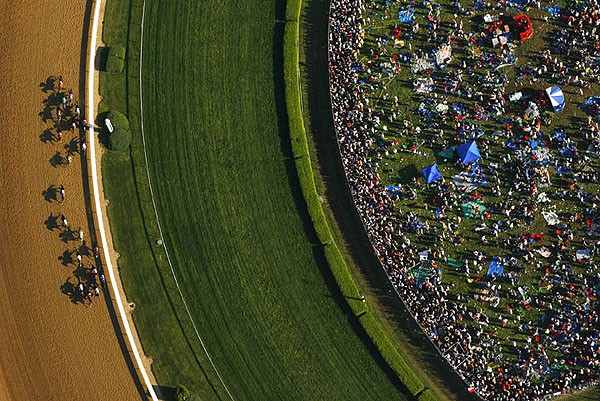
May 7, 2011 marks the 29th Kentucky Derby that Gary “Razor” Bogdon has photographed. He shared some of the magic of shooting the “Fastest Two Minutes in Sports” watched in person by over 150,000 spectators in our latest installment of Things You’ll Never Photograph.
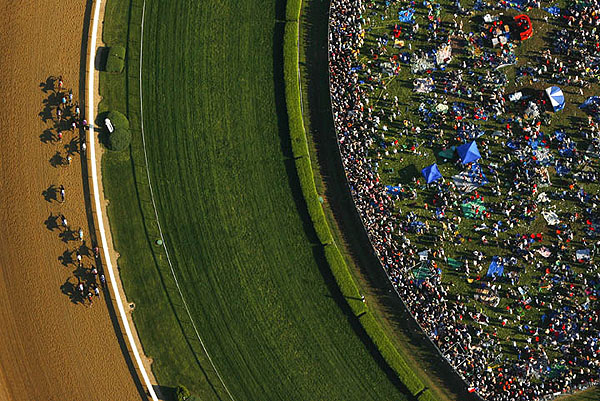
Can you give us some of your background? When did you gain an interest in photography? Where did you go to school? Did you study photography?
I was very fortunate to have grown up in the Louisville , KY area in the late 70’s and 80’s, which was the heyday for one of the best newspapers in the country for photojournalists: The Louisville Courier Journal and Times (back then, like most larger cities, there was a morning and an afternoon paper). I had an interest in photography and journalism since I was a sophomore in high school.
When my family moved from Frankfort, KY to the Louisville area, my high school newspaper and yearbook teacher and advisor at New Albany HS, Joyce Cookman, saw my interest and really nurtured it along with her husband Claude Cookman, who was a photo editor at the time for the CJ-Times. The Bingham family owned and operated business before selling it to Gannett in the late 80’s), and had some of the best photojournalists and photo editors in the country, right there in my backyard.
I still remember going over to the CJ’s darkroom on the weekends and learning how to process film (black and white in those days) and make prints and just trying to soak it all in, and learn from the best. I’m a people person, and got to be really good friends with everyone on the photo staff, but especially Bill Luster and Dan Dry, and spent all of my time trying to follow in their footsteps to soak up as much information from them that I could.
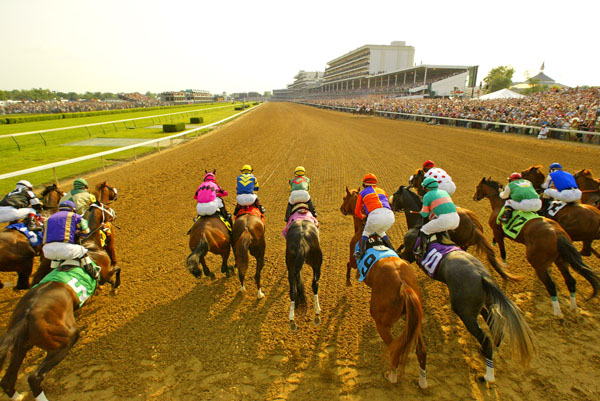
Tom Hardin was the Director of Photography at the time, and he too was very instrumental in shaping my career. It was the late 70’s and you could really ‘Feel the Force’ like Star Wars, in the CJ’s Photo Department. I’m still very close to Luster and Dry to this day and talk to them weekly.
I was editing negatives with them on the light table and commenting on how “razor sharp” some of their photos were. Thus my nickname was born, and they all started calling me “Razor.” My spiked up 80’s hair also probably had something to do with it. I must have listened to the Talking Heads, and Wham much , or maybe the puffy pants were too tight.
After high school I went on to study and received my BA degree from Indiana University School of Journalism, and those years at IU were also very influential on me as a photographer.
When did you start photographing the Kentucky Derby?
I think my very first Derby was in 1977, as a spectator with some high school friends in the infield, but my first Derby as a young photographer would have been in 1978 , as a “stringer” for the Courier Journal.
Even though the horses still run around the same track in about the same amount of time, a lot has changed since my first Kentucky Derby. Digital has replaced film (during my first Derby we only shot black and white film, then moved into color years later), and I’m sure my photography has grown as well.
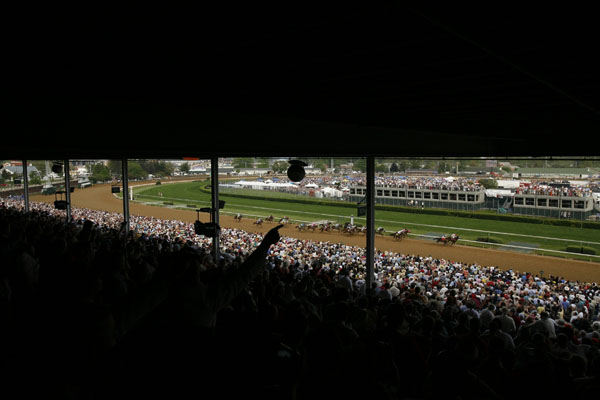
What kind of gear are you typically using? Are you shooting multiple locations with remotes?
I think the longest glass I had at the very first Derby was a 300mm 4.5 Nikon lens, and the focus ring was so tight, you almost needed pliers to turn it. Nowadays, I’m shooting with everything from a 14mm to a 600mm F4 lens. I also set up remote camera’s in different spots along the track and fire the remotely as the horses come into frame. I like to put a remote on the starting gate, sometimes in Turn 4, as well as the finish line, just to give myself several different ‘looks’ of the race. But there is nothing like standing on the dirt track as those horses come thundering towards you and the finish, and hoping for the great reaction at the finish line.
I shoot both Nikon and Canon gear, depending on what I’m looking to achieve. I also use Pocket Wizards for my remotes. Always bring rain gear (and pray for no rain) for you and your camera because I’ve seen every weather condition possible on Derby Day. I always bring some mud boots as well, because if it’s raining, or has been raining, you can’t slop through that muddy track in sneakers.

Hunter Thompson called the Derby “decadent and depraved.” Give us a sense of the crazy things you’ve seen on the infield. Have you photographed the culture around the race?
The infield has really toned down a lot since my first Derby and the late 70’s. I think it was only $5, to get into the infield back in those days. I’ve seen every trick in the book, as far as spectators trying to sneak in liquor from Ziploc bags with alcohol inside them, duct taped to their body, plugged watermelons full of vodka, small bottles hidden in the bottom of a bucket of KFC chicken.
Also clothes seemed to be a lot more optional back in the early days for both men and women. They are appealing to a much more upscale type of infield fan these days, but you still see some wild and funny stuff. And if it’s raining, you can guarantee you will find some belly flop contests going on in the infield. I don’t think Hunter S. Thompson was very far off when he made those comments about the Derby in the 70’s. I remember one Derby back in the 80’s when a very excited and (quickly angered) fan tossed his entire drink down my back when he realized that we had to stand in front of him when the race started. I told him we would kneel, but that didn’t seem to make much difference. He had too many mint juleps.
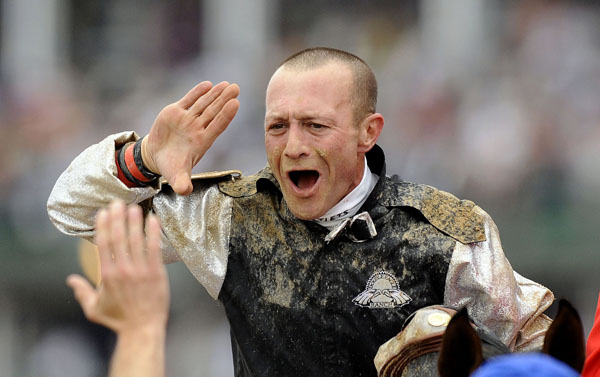
Photographing celebrities is all part of the day as well, from Bo Derek, Smokey Robinson, Justin Timberlake, Marisa Miller, Kid Rock , Members of Rascal Flatts, and even OJ Simpson (he’s busy now with other pressing issues ), it’s quite the day of fun and fashion.
You ventured into doing some video at Churchill Downs in 2010. What prompted you to move from stills to motion?
I’ve been doing more and more video work as a shooter, Director of Photography and even a Director for a number of my clients, which prompted me to shoot a video piece last year at Churchill Downs. With the newest technology that both Canon and Nikon have with the DSLR camera systems, it’s a natural fit and very exciting to work on. It’s like a new toy that you just got for Christmas , that you can’t wait to use .
You’ve photographed all the major sports around the US. What continues to attract you to the Derby?
I’ve shot every major sporting event , except Wimbledon, and the Kentucky Derby is by far my favorite to shoot. It’s the combination of the pageantry, colors, tradition, and the power of those horses coming at you for those 2 minutes, that gives me goose bumps. When you are standing there on the track, and listen to 100,000 people sing My Old Kentucky Home, it brings me back to an excited kid in high school, at his first Kentucky Derby. There is nothing like it that even compares.
Now I just need to find someone to hire me to shoot strawberries and cream this summer at Wimbledon. I’ll bring the Derby Pie and Mint Juleps!
Riders Up!
Previous Post: The Easiest Way to Distribute Photos


